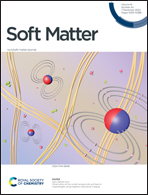Coalescence in concentrated emulsions: theoretical predictions and comparison with experimental bottle test behaviour†
Abstract
Fusion between emulsion drops, also called coalescence, may be undesirable for storage or sought after depending on the desired application. In this latter case, a complete separation of the two liquids composing the emulsion is required. The same objective may be applicable to foams. We have performed bottle test experiments on a model system of water in oil (w/o) emulsion stabilized by high amounts of hydrophobic surfactant Span 80. We observe two regimes for emulsion separation: the first regime, which is fast and includes sedimentation of the water droplets, and the second regime, which exhibits a very dense and stable emulsion zone. We predict the initial thickness of the dense zone as a simple function of surfactant concentration and mean droplet size. From the assumption that the coalescence rate depends only on the area of the thin film between two contacted droplets, we quantitatively model the separation kinetics of the dense emulsion zone. Our results give rise to a simple method that allows measuring the coalescence frequency per unit area, only by monitoring bottle test experiments.



 Please wait while we load your content...
Please wait while we load your content...